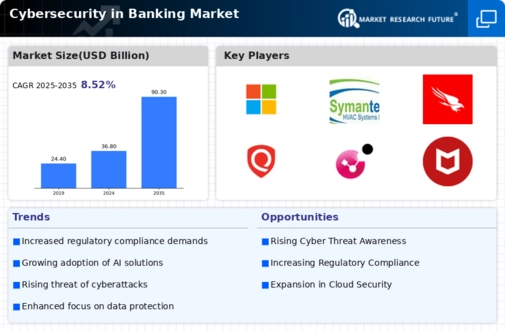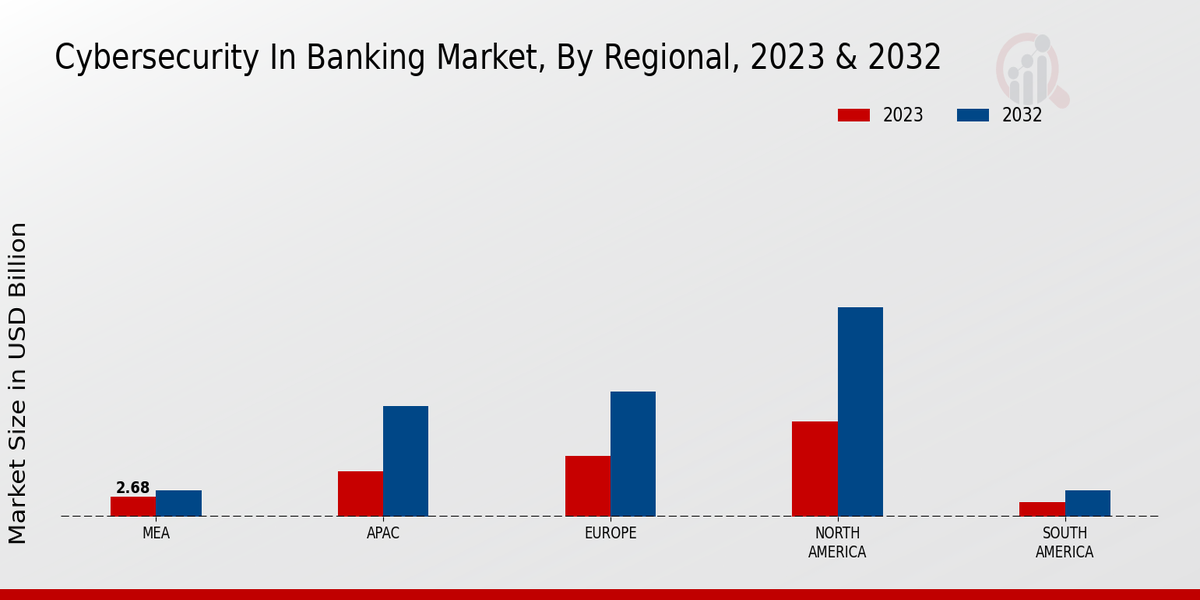Regulatory Compliance
Regulatory compliance remains a critical driver in the Global Cybersecurity in Banking Market Industry. Governments worldwide are implementing stringent regulations to protect consumer data and ensure financial stability. For instance, regulations such as the General Data Protection Regulation (GDPR) in Europe and the Gramm-Leach-Bliley Act in the United States compel banks to adopt comprehensive cybersecurity strategies. As compliance requirements evolve, financial institutions are likely to allocate substantial resources to meet these standards. This focus on regulatory compliance not only enhances security but also fosters consumer confidence, ultimately contributing to the market's projected growth to 90.3 USD Billion by 2035.
Increasing Cyber Threats
The Global Cybersecurity in Banking Market Industry is currently experiencing a surge in cyber threats, which is driving the demand for robust security solutions. Financial institutions are increasingly targeted by cybercriminals due to the sensitive nature of their data and the potential for significant financial gain. In 2024, the market is valued at 36.8 USD Billion, reflecting the urgent need for enhanced cybersecurity measures. Banks are investing heavily in advanced technologies such as artificial intelligence and machine learning to detect and mitigate threats in real-time. This trend indicates a growing recognition of the importance of cybersecurity in safeguarding customer trust and financial stability.
Market Growth Projections
The Global Cybersecurity in Banking Market Industry is projected to experience substantial growth in the coming years. With a market value of 36.8 USD Billion in 2024, it is anticipated to reach 90.3 USD Billion by 2035. This growth trajectory suggests a compound annual growth rate of 8.5% from 2025 to 2035. Such projections underscore the increasing importance of cybersecurity in the banking sector as institutions strive to protect sensitive data and maintain customer trust. The anticipated growth reflects a broader recognition of the need for comprehensive cybersecurity strategies in an increasingly digital and interconnected financial landscape.
Digital Transformation Initiatives
The ongoing digital transformation initiatives within the banking sector are significantly influencing the Global Cybersecurity in Banking Market Industry. As banks increasingly adopt digital platforms for customer engagement and service delivery, the attack surface for cyber threats expands. This necessitates the implementation of sophisticated cybersecurity frameworks to protect sensitive information. The shift towards mobile banking and online transactions has prompted financial institutions to prioritize cybersecurity investments. Consequently, the market is expected to grow at a compound annual growth rate of 8.5% from 2025 to 2035, reflecting the urgent need for secure digital infrastructures that can withstand evolving cyber threats.
Integration of Advanced Technologies
The integration of advanced technologies is a pivotal driver in the Global Cybersecurity in Banking Market Industry. Innovations such as artificial intelligence, machine learning, and blockchain are being leveraged to enhance security protocols and streamline operations. These technologies enable banks to analyze vast amounts of data for potential threats and automate responses to incidents. As financial institutions increasingly adopt these technologies, the demand for cybersecurity solutions is expected to rise. This trend not only improves the efficiency of security measures but also positions banks to better anticipate and respond to emerging cyber threats, thereby fostering a more secure banking environment.
Rising Awareness of Cybersecurity Risks
There is a growing awareness of cybersecurity risks among banking institutions, which is propelling the Global Cybersecurity in Banking Market Industry forward. Financial organizations are increasingly recognizing that a single breach can lead to substantial financial losses and reputational damage. This heightened awareness is prompting banks to invest in comprehensive cybersecurity training programs for employees and to adopt advanced security technologies. As a result, the market is witnessing a shift towards proactive security measures rather than reactive responses. This trend is likely to contribute to the overall growth of the market, as institutions strive to create a culture of security that prioritizes risk management.















